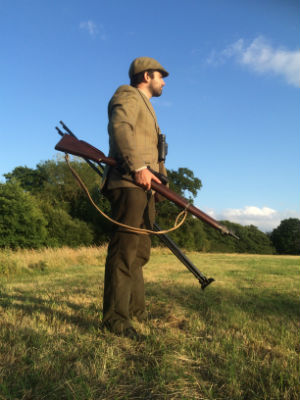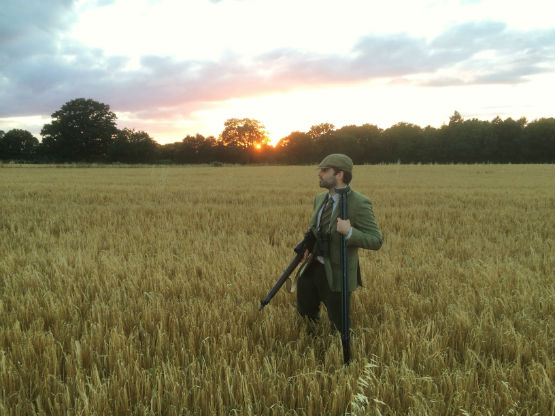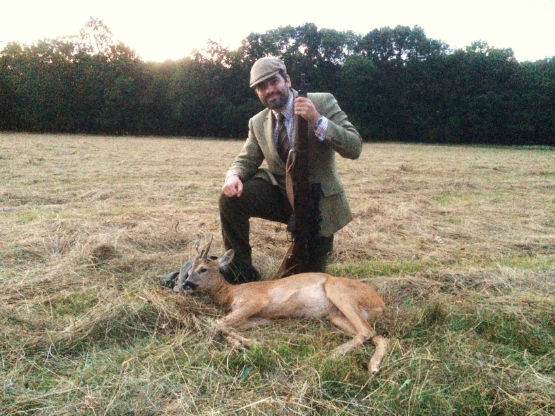Guy Hunter steps back in time, armed with a 1943 .303 Rifle in search of Roe Buck with County Deer Stalking’s James Mott.
As the British Empire’s standard issue cartridge for the first half of the twentieth century, the .303 certainly has a storied history. Indeed, it is said that it has likely accounted for more medium and large game around the world than any other round. Partly this is due to its ubiquity but it is also testament to the rifles that were chambered for it.
Going all the way back to the original Lee Metford rifle through to the No.4 Mk.II, these weapon systems have proven themselves to be archetypal military rifles. From the arid veldt of South Africa, through Flanders mud and Burmese jungle, to the frozen wastes of the Canadian north, there isn’t an environment on earth that a Lee Enfield has been tested in and found wanting. During the First World War, it was remarked that while the Germans, with their beautifully engineered Mauser, had a hunting rifle and the Americans, with their heavy and powerful Springfield had armed themselves with a target rifle, it was the British with the Lee Enfield that had a soldier’s battle rifle.
Its superbly slick rear-locking action gave unmatched rate of fire while maintaining accuracy that was sufficient for the task in hand and also brought that most prized of attributes for military weapons: reliability. This was a weapon famous for its ability to shrug off the rigours of combat and keep on firing when you needed it most. This attribute also endeared it to the many thousands of hunters and outdoorsmen around the world who acquired one when the .303 was finally abandoned by the government in the 1950s for a standardised 7.62x51 NATO cartridge.
 Both as a keen military historian and a serving member of the Armed Forces, I was keen to own one of these rifles as soon as my FAC was granted. Advice from knowledgeable friends urged caution – there are still many of these rifles around and although prices have climbed significantly over the last few years, there are still bargains to be had and it is certainly worthwhile to wait for a good example to come along.
Both as a keen military historian and a serving member of the Armed Forces, I was keen to own one of these rifles as soon as my FAC was granted. Advice from knowledgeable friends urged caution – there are still many of these rifles around and although prices have climbed significantly over the last few years, there are still bargains to be had and it is certainly worthwhile to wait for a good example to come along.
My luck was in when I contacted Valmont Firearms about a recent shipment of rifles they had acquired. Provided to the Italian Army in 1945 (after they decided that it was better to be on the winning side!), these rifles had been shipped without any ammunition to accompany them and, indeed, none was to follow. They had been drilled with and dutifully cleaned but not fired for around 20 years before being boxed up and forgotten in a warehouse. Freshly returned from the proof house when I bought it, my example – 1943 No.4 Mk.1 built at Long Branch in Canada - has an absolutely pristine bore, the most critical thing to check when buying one of these rifles as ‘a shooter.’
Stalking with these beautiful old rifles may be frowned upon for several reasons. It certainly isn’t a gentleman’s weapon – the archaic muzzle velocity limits in Scotland were deliberately set too high so as to exclude the .303, so that anyone who wanted to stalk necessarily had to be able to afford a rifle more expensive than the many cheap military surplus Enfield-based sporters that flooded the market in the 1950s. Even having found a good example, it’s hardly accurate by modern standards – 1.5-2 MoA – but that’s certainly sufficient for the woodland. Finally, in view of the historical significance and age of these rifles, particularly some of the battle-worn S.M.L.E.s which may be over a hundred years old, it’s probably not a good idea to drag them out every week in inclement weather or to modify any original parts. Indeed, these are more cherished pieces, to be taken out of the cabinet when conditions are 'just right' for the occasional sun-dappled stalk.
Converting the battle-winner to a trophy-taker required little more than some basic woodwork and a comb through the stalls at the Bisley Phoenix Weekend. The original butt was replaced with a surplus walnut long butt (a desirable feature which increases the LOP to something approximate to most modern rifles – three sizes were routinely manufactured but the majority were ‘mediums’), a brass butt plate sourced and a cheek rest – as fitted to the now ultra-rare No.4(T) sniper model – was sanded, stained, oiled and screwed on to my non-original butt. An all steel scope mount which required no drilling or alteration of the original action was fitted and topped with a Zeiss 6x42 scope. The irony of fitting German optics did not escape me but some concessions are inevitable, especially when it improves the likelihood of a clean-killing shot.
Recently, having spent the week shooting at the Imperial Meeting, the stalking bug bit hard and feeling the need for a different shoot, I sought another trip out. Word-of-mouth pointed me to County Deer Stalking, a leading supplier of deer stalking outings in the south east of England. Their assistant manager, James Mott, an accomplished stalker and guide in his own right, was to take me and my old warhorse of a rifle on a walk through the beautiful Hampshire countryside looking for roebuck on an uncharacteristically torpid and sunny afternoon.
An early afternoon start with a zero check and several foot stalks unfortunately gave us no joy. While walking through such beautiful countryside has charms all its own, the quest for a buck gave us defined purpose and eventually we were rewarded. With the light failing, the final option for the day was to approach a high seat in an area known to be thick with deer.
Stalking through a treeline, 10 yards short of the seat, a solitary four-pointer was sighted through the trees, browsing the grass in a large glade. James raised his binoculars, smiled and whispered “ready for your roebuck?”
Heart in mouth, picking my way through the brush and slowly ascending the seat, I gained a good sight picture. He stood 200 yards off, not an easy shot with my elderly rifle. James silently joined me and continued to spot the buck, who was still completely unaware of our presence.
 “Aim a bit higher, just below his spine...wait for him to stop.” I held my breath in anticipation.
“Aim a bit higher, just below his spine...wait for him to stop.” I held my breath in anticipation.
The buck, meandering through the freshly cut grass paused for a moment – it was all that was needed.
Almost instinctively, the 150gr softpoint was on its way. As the harsh crack reverberated around the glade, the buck stopped, shuddered and took a few slow steps. As I worked the bolt, James urged “hit him again.” The second round dropped him on the spot. A solitary fallow doe suddenly appeared, ‘pronking’ around the glade, disturbed by the noise but apparently unsure of what had transpired – we waited for her to depart and then followed up.
A nice 4 point buck, around 2 years old, lay where he was hit, the .303 having done its work exactly as designed all those years ago. A short drag back to the vehicle followed the gralloch as the light faded fast and the day was done.
These beautiful old weapons are not tools for the deer manager who requires a rifle that he can rely on for pinpoint accuracy after using it day-in, day-out in all weather conditions. While in their day, these certainly were robust battle rifles, they are now pieces of history, to be treated with a certain degree of reverence and care. But, when conditions are right, with the sun shining, the wind in your face and the smell of Young’s 303 oil permeating through your nostrils as you line up the shot, a modern composite-stocked rifle cannot replicate the excitement one feels on successfully completing a stalk using a true British legend.
This article also appears in the October 2015 edition of ‘sporting-rifle' (No 121). Our Thanks to Guy Hunter from whom we hope to see further articles in the coming months.
To read more about the 303 Calibre follow this link: 303-british





















